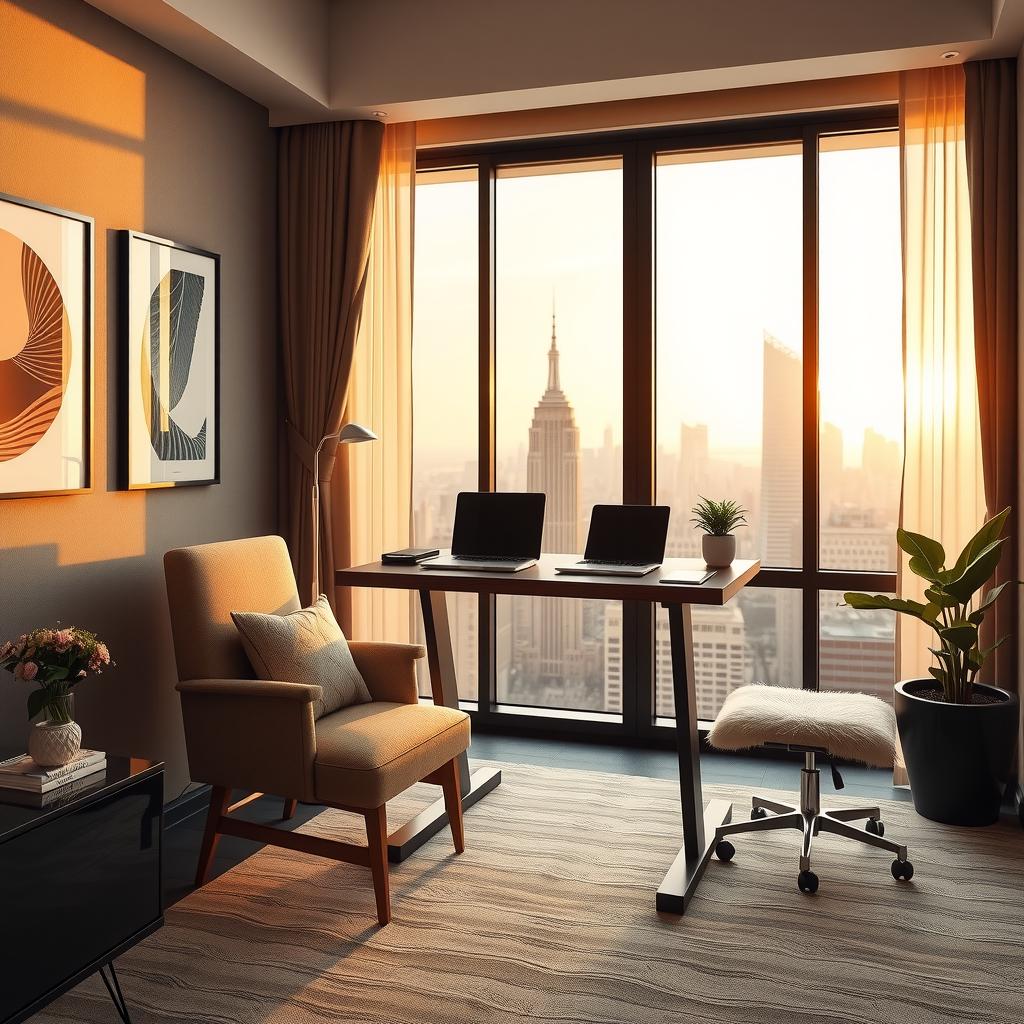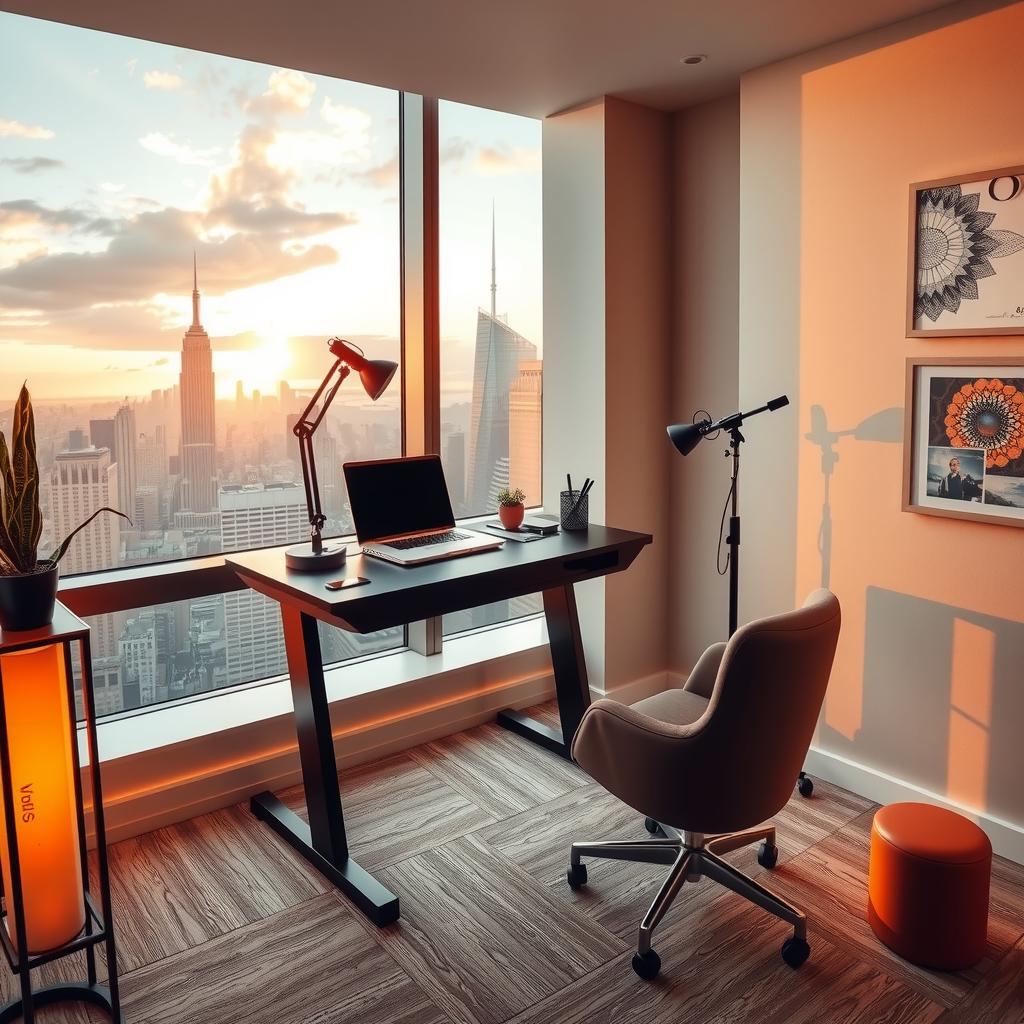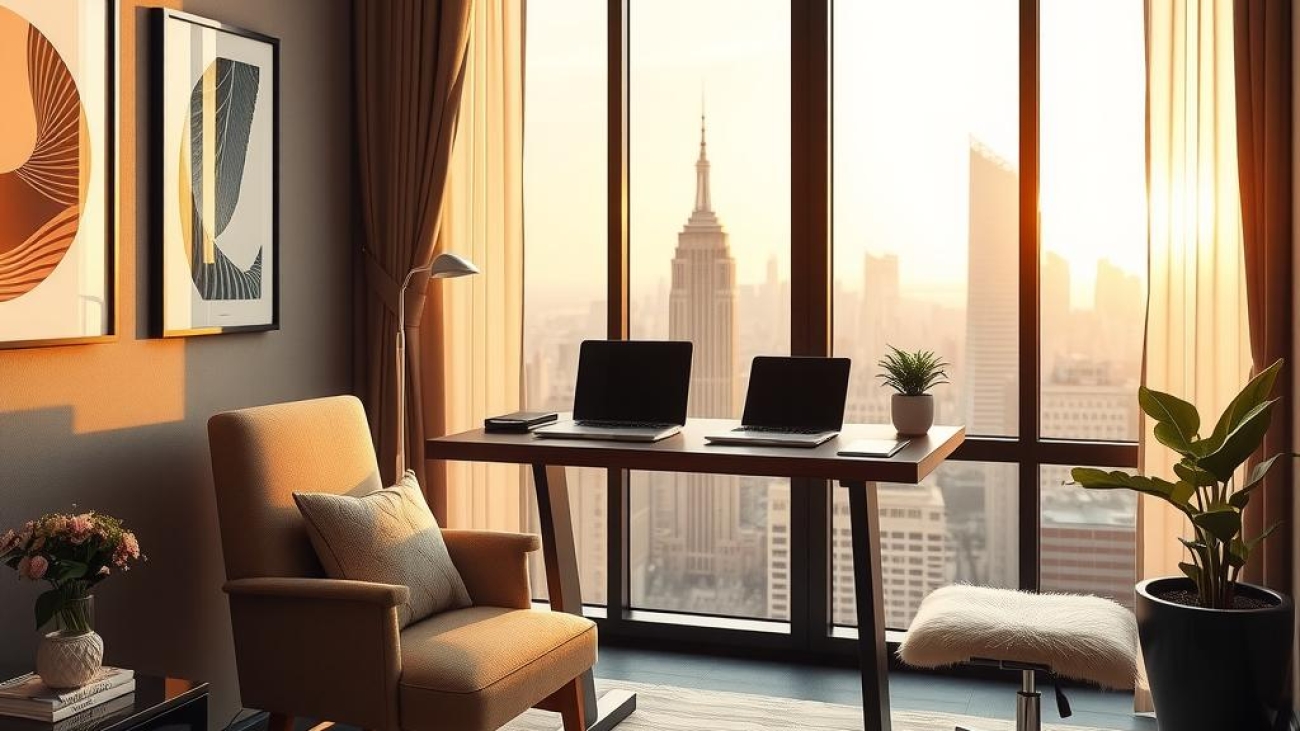In a world where remote work has become the norm, digital nomads are redefining the concept of productivity by transforming hotels into their temporary offices. However, many overlook a critical component of effective remote work: an ergonomic setup. The challenge lies in creating a comfortable and efficient workspace in environments that were not designed for long hours of desk work. With hotel rooms often limited in space and resources, achieving optimal office ergonomics can feel daunting. Yet, it is essential for maintaining health and maximizing productivity while traveling.
This article seeks to explore how digital nomads can cultivate an ergonomic office setup within their hotel accommodations, ensuring that they remain productive while on the move. By addressing common pitfalls such as poor seating arrangements or inadequate lighting conditions typically found in hotel rooms, readers will discover practical strategies to create a travel-friendly office environment tailored to their unique needs.
Key considerations include selecting appropriate equipment like portable chairs that offer comfortable seating, compact standing desks for flexibility, and organizational tools that optimize space usage without sacrificing functionality. Such elements contribute significantly to fostering an efficient workspace even within the confines of a modest hotel room.
Readers will also find valuable productivity tips aimed at integrating wellness into their routine—because when one feels good physically, they tend to perform better mentally too! Moreover, understanding how simple adjustments can enhance comfort during long working hours is pivotal for those who rely on hotels as flexible workspaces throughout their travels.
By delving deeper into these solutions tailored specifically for digital nomads living out of suitcases yet yearning for stability amidst constant change, this blog post aims to equip them with actionable insights necessary for crafting an ergonomic oasis wherever they choose to set up shop—even if it’s just temporarily in a hotel room.

Key Points:
-
Portable Monitor Solutions: Utilizing portable monitors can significantly enhance productivity for digital nomads. These compact devices, such as the ASUS ZenScreen or AOC e1659Fwu, allow users to extend their workspace beyond a single laptop screen, making it easier to multitask and manage multiple applications simultaneously. By incorporating a flexible workspace, travelers can create an environment that mimics their office setup while optimizing comfort and efficiency within hotel rooms.
-
Adjustable Laptop Stands: To maintain proper posture and reduce strain during long hours of work, adjustable laptop stands are essential tools for any remote worker on the move. Products like the Rain Design mStand or MOFT X offer adaptable height options that help elevate laptops to eye level, promoting better alignment of the spine and neck. This innovation in office ergonomics ensures that digital nomads can focus on delivering quality results without compromising their physical health.
-
Travel-Friendly Keyboards: Compact keyboards designed for travel provide an excellent solution for those seeking comfortable seating arrangements while working remotely. Devices such as the Logitech K380 or Microsoft Universal Foldable Keyboard are lightweight and easy to pack, allowing users to type comfortably without straining their wrists. By integrating these ergonomic products into their setups, digital nomads will find they can achieve a more efficient hotel workspace conducive to creativity and concentration amidst ever-changing locations.
By embracing these practical solutions tailored specifically for transient environments like hotels, digital nomads can successfully navigate their unique challenges related to remote work setups.

Understanding Ergonomics: The Importance of a Functional Workspace
Enhancing Productivity and Comfort for Digital Nomads
In the ever-evolving landscape of remote work, particularly for digital nomads, establishing an ergonomic workspace in transient environments is paramount. The unique challenges faced by these individuals—ranging from fluctuating internet connectivity to varying levels of comfort in hotel workspaces—can significantly impact productivity and overall well-being. Implementing basic principles of office ergonomics allows digital nomads to create a flexible yet efficient workspace that caters to their dynamic lifestyle. For instance, utilizing portable ergonomic solutions such as compact laptop stands, adjustable chairs, or even travel-friendly keyboards can transform any temporary setup into a hub conducive to focus and creativity. Therefore, understanding how each component contributes not only enhances comfort but also fosters sustained productivity amidst change.
Creating Effective Workspaces on the Go
The adaptability required by digital nomads often leads them to diverse locations—from bustling cafes in urban centers to serene beaches with Wi-Fi access. Consequently, it becomes essential for them to develop strategies around creating comfortable seating arrangements that support prolonged periods of work without compromising health. An effective ergonomic setup should prioritize proper posture; ensuring that screens are at eye level while feet rest flat on the ground can alleviate strain on the neck and back during extended hours spent typing away at keys. Furthermore, incorporating frequent movement breaks into one’s routine aligns perfectly with numerous productivity tips, which state that short intervals dedicated to stretching or walking can re-energize both body and mind.
Travel-Friendly Office Solutions
As digital nomads traverse various geographical locations, they often encounter limited resources when it comes time to establish their temporary office setups. This challenge underscores the importance of investing in practical remote work solutions designed specifically for portability without sacrificing functionality or comfort. A thoughtfully curated toolkit might include lightweight lap desks designed with cushioning for added support during long working hours or noise-canceling headphones aiding concentration amid distractions common in public spaces. By prioritizing these elements within their mobile offices, digital nomads can create an environment where they feel empowered rather than hindered by external factors—a critical aspect contributing toward maintaining high levels of productivity regardless of location.
The Role of Flexible Work Environments
Flexibility plays an integral role in enhancing one’s ability to adapt effectively while fulfilling job responsibilities across different settings worldwide—a hallmark feature appealing greatly among those who pursue a life less ordinary as digital nomads seek adventure while balancing careers remotely! Thus embracing versatility within our workstations invites opportunities for optimizing conditions tailored suited directly towards individual preferences—ultimately cultivating environments rich enough so each moment invested feels purposeful leading towards achieving desired goals efficiently! One must also consider how environmental elements such as lighting affect mood; brightening up dim corners through strategic use lamps could boost motivation alongside increasing overall satisfaction experienced throughout daily tasks undertaken within chosen spaces!
By weaving together these aspects related explicitly concerning ergonomics within transient lifestyles enjoyed by many modern-day professionals today—the irrefutable benefits stemming from designing functional workplaces resonate loudly concluding this exploration warrants attention deservedly given its potential elevating experiences fostered wherever journeys may lead next over time ahead!
Essential Tools for Digital Nomads
Creating a Productive and Comfortable Work Environment on the Move
Digital nomads face unique challenges when it comes to maintaining an ergonomic setup while traveling. As they navigate through various locations—from bustling cafes to serene hotel workspaces—the need for reliable and portable equipment becomes paramount. To optimize productivity, these remote workers should consider investing in versatile tools like portable monitors, adjustable stands, and comfortable seating options that promote good posture and reduce strain during long hours of work. A well-thought-out office ergonomics strategy can significantly enhance their efficiency.
One essential tool is the portable monitor. It allows digital nomads to extend their screen space without adding bulk to their travel gear. Lightweight models often come with features such as built-in batteries or USB connections, making them easy to set up wherever they are—be it at a co-working space or a quiet corner in a hotel lobby. By having additional screen real estate, individuals can multitask more effectively, streamlining their workflow as they juggle emails, virtual meetings, and project management tasks simultaneously.
Adjustable laptop stands are another game-changer for those seeking an ergonomic workspace on the go. These stands elevate laptops to eye level, reducing neck strain caused by hunching over screens for extended periods. Many models fold flat into compact sizes that fit easily into backpacks or carry-on luggage—ideal for any travel-friendly office environment. When combined with external keyboards and mice, these setups create an efficient workspace that mirrors traditional office settings but remains flexible enough to suit varied environments.
Comfortable seating options also play a crucial role in establishing productive work habits while traveling. For instance, inflatable lumbar support pillows can transform any chair into an ergonomic seat by offering necessary back support throughout long working sessions at makeshift desks found in hotels or coffee shops. Additionally, some digital nomads may opt for portable hammocks designed specifically for lounging yet adaptable enough for impromptu working conditions outside—a perfect blend of comfort and utility that enhances overall productivity.
Furthermore, prioritizing quality over quantity when selecting tools is vital; investing in durable products ensures longevity amidst frequent relocations associated with the lifestyle of digital nomadism. In conclusion, integrating elements such as portable monitors, adjustable laptop stands, and comfortable seating within one’s travel kit will not only foster better remote work solutions, but also cultivate healthier habits conducive to sustained performance across diverse environments—an essential aspect of thriving as modern-day professionals on the move.
Creating Your Ideal Workspace Anywhere
Practical Strategies for Flexibility and Productivity in Various Settings
In today’s fast-paced world, the rise of digital nomads has necessitated the creation of functional workspaces that can adapt to any environment, whether it be a hotel or a co-working space. As remote work solutions evolve, it’s essential for individuals to assemble an efficient workspace that promotes productivity while ensuring comfort. One effective strategy is to prioritize office ergonomics by selecting travel-friendly office equipment such as portable laptop stands and compact keyboards. This not only fosters better posture but also enhances focus during long hours of work away from traditional offices. Furthermore, assessing seating options becomes crucial; choosing locations with comfortable seating can significantly impact overall productivity levels.
To optimize one’s workspace in hotels or co-working spaces, employing a few organization tips is beneficial. A well-structured setup includes decluttering the desk area and utilizing organizers for documents and tech gadgets. Integrating a reliable power source is vital too—ensuring access to charging ports can prevent interruptions caused by low battery life on devices essential for remote work tasks. Additionally, establishing boundaries between leisure and work areas within these flexible spaces helps maintain concentration levels throughout the day.
Moreover, lighting plays a pivotal role in creating an ideal working atmosphere; natural light boosts mood and energy levels while reducing eye strain associated with prolonged screen time. When possible, opting for spots near windows or areas with ample light can enhance one’s ability to stay engaged with tasks at hand. If natural lighting isn’t feasible due to location constraints, investing in portable LED lights designed specifically for enhancing workspace illumination could serve as an alternative solution.
Another key aspect involves leveraging technology effectively; using apps that assist in time management or project tracking ensures deadlines are met even when distractions abound in bustling environments like hotels or shared office spaces. Regular breaks are also integral components of maintaining high productivity; stepping away momentarily allows individuals to recharge mentally before diving back into their workload refreshed and focused.
Ultimately, creating your ideal workspace anywhere comes down to personalizing settings based on individual preferences while adhering closely to principles of ergonomic design and efficiency practices tailored towards diverse working landscapes available today—be they transient hotel rooms or vibrant co-working hubs filled with fellow professionals pursuing similar goals of success through flexibility without compromising quality output.
Creating the perfect ergonomic office setup in hotels for digital nomads is essential for fostering productivity and maintaining physical well-being. As these remote workers frequently transition from one location to another, they face unique challenges in establishing a functional workspace within often limited hotel environments. By utilizing travel-friendly office products tailored for flexibility, digital nomads can overcome these hurdles and create an efficient workspace that meets their individual needs.
One crucial aspect of an ergonomic setup is selecting the right tools that enhance comfort while working long hours. Portable monitors like the ASUS ZenScreen or adjustable laptop stands such as the Rain Design mStand can significantly improve posture by elevating screens to eye level, thereby reducing neck strain. Additionally, incorporating a compact mechanical keyboard like the Keychron K1 allows for comfortable typing experiences without taking up much space in luggage. Emphasizing office ergonomics ensures that even transient workspaces promote both health and efficiency.
Comfortable seating options are also vital components of an effective hotel workspace. Digital nomads should consider investing in inflatable lumbar support cushions or portable seat covers designed to provide additional back support during prolonged sitting sessions on less-than-ideal hotel chairs. Products such as the Everlasting Comfort Lumbar Support Pillow help maintain proper spinal alignment, contributing to overall well-being while tackling remote projects from any corner of the globe.
To further optimize their setups, digital nomads should explore versatile desk accessories designed with travel in mind. Items like collapsible desk organizers or multi-functional power strips can keep workspaces tidy and ensure easy access to necessary devices without cluttering valuable surfaces. A product like Anker’s PowerPort Cube not only offers multiple charging ports but also features a compact design perfect for small hotel desks. By embracing these practical tips focused on creating personalized yet flexible workspaces, digital nomads are empowered to maximize productivity regardless of where they find themselves working.
FAQ:
Q: What are some essential tools for setting up an ergonomic office in hotels?
A: Essential tools include portable monitors like ASUS ZenScreen, adjustable laptop stands such as Rain Design mStand, compact keyboards like Keychron K1, and comfortable seating solutions including inflatable lumbar support cushions.
Q: How can I create a productive workspace with limited resources?
A: To create a productive workspace with limited resources, utilize travel-friendly office products such as collapsible desk organizers and multi-functional power strips which aid organization while saving space.
Q: Why is understanding office ergonomics important for digital nomads?
A: Understanding office ergonomics is crucial because it helps maintain physical health and mental clarity during extended periods of remote work by minimizing strain associated with improper posture or uncomfortable seating arrangements.
